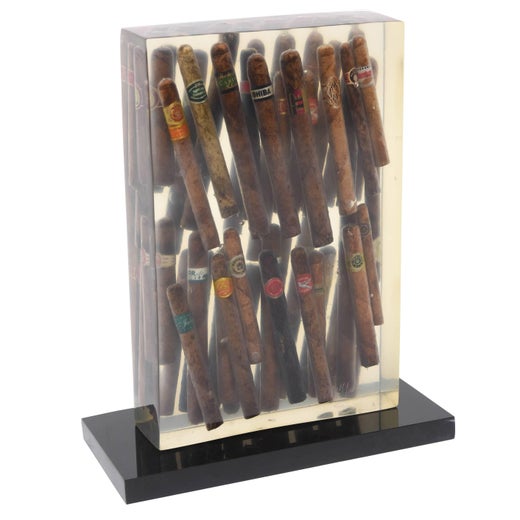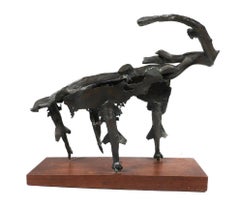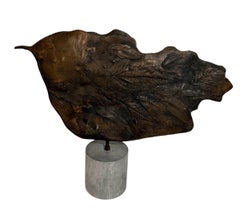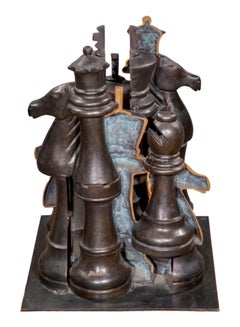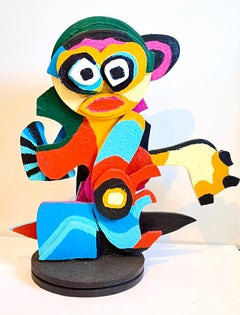Want more images or videos?
Request additional images or videos from the seller
1 of 19
ArmanFrench Pop Art Assemblage Sculpture Watch Movements Temps 2 Arman Accumulation1976
1976
Price:$7,000
$9,000List Price
About the Item
- Creator:Arman (1928 - 2005, French)
- Creation Year:1976
- Dimensions:Height: 18.25 in (46.36 cm)Width: 18.25 in (46.36 cm)Depth: 4.38 in (11.13 cm)
- Medium:
- Movement & Style:
- Period:
- Condition:minor wear typical for age and materials. please see photos.
- Gallery Location:Surfside, FL
- Reference Number:1stDibs: LU38216104692
Arman
Arman was born in Nice, France, in 1928, and showed a talent for painting and drawing as a child. He studied at the the Ecole Nationale des Art Décoratifs in Nice followed by studies at the École du Louvre in Paris. In his early years he focused on abstract paintings. Then, in 1957, he became interested in common objects as works of art. He first did what came to be called his "allures d"objet" (object impressions), where he would dip an object into paint and press it on canvas thus leaving the object's shadow or impression. Then he decided the object itself was worth paying attention to and started to treat them in his own way. His intention was to remove the material purpose of an object so that its only remaining function was to "feed the mind" as a work of art. What better way to achieve that result than by breaking, slicing or even burning objects such as violins, telephones, typewriters or even whole cars? He also made objects useless by accumulating them, such as 2,000 wristwatches in a Plexiglass box that all kept different time. Once emotionally detached from the circumstances associated with a broken object, the viewer could grow to appreciate its abstract beauty; so, in a sense, Arman was literally teaching that things one never thought could be regarded as attractive could indeed turn out to be so. Through this achievement, Arman gained worldwide recognition and is regarded as one of the most prolific and inventive creators of the late 20th century. His work can be found in the collections of numerous museums including the Metropolitan Museum of Art in New York, the Tate Gallery in London and the Centre Pompidou in Paris. Arman’s work has also been exhibited in galleries, museums and public spaces worldwide including the Musée D’Art Contemporain in Tehran, Iran; the Museum of Art in Tel Aviv, Israel; the Musée Des Arts Decoratifs and Opéra De Paris in France; the La Jolla Museum of Contemporary Art in California; and the Museum of Arts and Design and the Guggenheim in New York He died in 2005 in New York.
About the Seller
4.9
Platinum Seller
Premium sellers with a 4.7+ rating and 24-hour response times
Established in 1995
1stDibs seller since 2014
1,810 sales on 1stDibs
Typical response time: 1 hour
Authenticity Guarantee
In the unlikely event there’s an issue with an item’s authenticity, contact us within 1 year for a full refund. DetailsMoney-Back Guarantee
If your item is not as described, is damaged in transit, or does not arrive, contact us within 7 days for a full refund. Details24-Hour Cancellation
You have a 24-hour grace period in which to reconsider your purchase, with no questions asked.Vetted Professional Sellers
Our world-class sellers must adhere to strict standards for service and quality, maintaining the integrity of our listings.Price-Match Guarantee
If you find that a seller listed the same item for a lower price elsewhere, we’ll match it.Trusted Global Delivery
Our best-in-class carrier network provides specialized shipping options worldwide, including custom delivery.You May Also Like
DAVIDE QUAYOLA "Laocoon Fragment #8_005.003 mixed media iron wood sculpture 2016
Located in Rancho Santa Fe, CA
Davide Quayola (Italian, b. 1982)
"Laocoon Fragment #8_005.003"
2016
Made of Iron, epoxy, fiberglass, mirror-polished steel & wood.
Dimensions: 19.7 x 11 x 15.75 inches (50 x 28 x 40 cm)
Base Plate Dimensions: .8 x 23.7 x 23.7 inches (2 x 60 x 60 cm) base
From the signed and numbered edition of 3
"Quayola employs technology as a lens to explore the tensions and equilibriums between seemingly opposing forces: the real and artificial, figurative and abstract, old and new. Constructing immersive installations, he engages with and re-imagines canonical imagery through contemporary technology. Landscape painting, classical sculpture and iconography are some of the historical aesthetics that serve as a point of departure for Quayola’s hybrid compositions. His varied practice, all deriving from custom computer software, also includes audiovisual performance, immersive video installations, sculpture, and works on paper.
His work has been performed and exhibited in many prestigious institutions worldwide including V&A Museum, London; Park Avenue Armory, New York; National Art Center, Tokyo; UCCA, Beijing; How Art Museum, Shanghai; SeMA, Seoul; Palais de Tokyo, Paris; Ars Electronica, Linz; Sonar Festival, Barcelona and Sundance Film Festival.
Also a frequent collaborator on musical projects, Quayola has worked with composers, orchestras and musicians including London Contemporary Orchestra, National Orchestra of Bordeaux, Ensemble Intercontemporain, Vanessa Wagner, Jamie XX...
Category
2010s Abstract Abstract Sculptures
Materials
Steel, Iron
$35,000
H 19.7 in W 11 in D 15.75 in
Untitled 06 - 21st Century, Sculpture, Installation Art, Organic, Black, Metal
By Zsolt Berszán
Located in Baden-Baden, DE
Untitled 06, 2016
Mixed media on metal sheet
(Signed on reverse)
31 1/2 H × 70 9/10 W × 39 2/5 D in
80 H × 180 W × 100 D cm
Zsolt Berszán’s work speaks of repulsion and fascination and at the same time speaks about shapes that lie on the border between hallucination and obsession wherein the identity and order were disrupted.
Themes such as the double and the metamorphosis, otherwise put, themes of atrophied characters are all representations of the abject.
Berszán’s creation is located at the fine border between the representation of identity and its dissolution thusly aiming to represent the non-symbolized. The dynamic separation and the transitional object...
Category
2010s Abstract Abstract Sculptures
Materials
Metal, Wire
$10,235
H 19.69 in W 78.75 in D 43.31 in
Security Knight 646 - Contemporary Mixed Media Armor Sculpture
Located in New York, NY
Security Knight 646 from Linda Stein’s Knights of Protection series functions both as a defender in battle and a symbol of pacifism. The series references popular and religious icon...
Category
2010s Contemporary Abstract Sculptures
Materials
Metal
$36,000 Sale Price
20% Off
H 58 in W 19 in D 16 in
Linda Stein, W 629- Contemporary Mixed Media Silver Black Metal Armor Sculpture
Located in New York, NY
W 629 from Linda Stein’s Knights of Protection series functions both as a defender in battle and a symbol of pacifism. The series references popular and religious icons such as Wond...
Category
Early 2000s Contemporary Abstract Sculptures
Materials
Metal
$36,000 Sale Price
20% Off
H 58 in W 18 in D 14 in
Linda Stein, Vestment 628 - Contemporary Mixed Media Metal Wood Armor Sculpture
Located in New York, NY
Vestment 628 from Linda Stein’s Knights of Protection series functions both as a defender in battle and a symbol of pacifism. The series references popular and religious icons such ...
Category
Early 2000s Contemporary Abstract Sculptures
Materials
Metal
$36,000 Sale Price
20% Off
H 52 in W 18 in D 16 in
American Contemporary Mixed Media Sculpture - Linda Stein, Country Knight 643
Located in New York, NY
This sculpture from Linda Stein’s Knights of Protection series functions both as a defender in battle and a symbol of pacifism. The series references popular and religious icons suc...
Category
Early 2000s Contemporary Abstract Sculptures
Materials
Metal
$35,000
H 58 in W 19 in D 15 in
Too Many Teardrops Suncatcher
By Roxana Azar
Located in Philadelphia, PA
This Mixed Media piece titled "Too Many Teardrops Suncatcher" is an original artwork by Roxana Azar made of digital print on acrylic, plastic chain, metal, and glass. The piece measu...
Category
21st Century and Contemporary Contemporary Figurative Sculptures
Materials
Metal
Beyond the Visible (multi dimensional tower sculpture)
By Yaacov Agam
Located in Aventura, FL
Multi dimensional tower sculpture (polymorph screen print on folded PVC) on brass base. Hand signed by Yaacov Agam. Hand numbered 66/150 (slightly faded - see pic). Size: 34.25 x ...
Category
1970s Abstract Abstract Sculptures
Materials
Screen, PVC
$25,875 Sale Price
25% Off
H 34.25 in W 8.75 in D 8.75 in
Kinetic sculpture made from coins "Circle XXXV" by Kim Seungwoo
By Kim Seungwoo
Located in Palm Beach, FL
Kim Seungwoo is a contemporary Korean sculptor, lives in Seoul, South Korea.
Seungwoo is famous for his sculptures made from coins and buttons. He create...
Category
2010s Abstract Geometric Abstract Sculptures
Materials
Plastic
$10,000
H 6.3 in W 11.82 in D 6.3 in
Kinetic sculpture made from coins "Circle XXXIV" by Kim Seungwoo
By Kim Seungwoo
Located in Palm Beach, FL
Kim Seungwoo is a contemporary Korean sculptor, lives in Seoul, South Korea.
Seungwoo is famous for his sculptures made from coins and buttons. He create...
Category
2010s Abstract Geometric Abstract Sculptures
Materials
Plastic
$12,000
H 19.69 in W 17.72 in D 7.88 in
More From This Seller
View AllBronze Sculpture Abstract Brutalist Goat or Ram WPA Artist Mounted on Base
By Benedict Michael Tatti
Located in Surfside, FL
Benedict Tatti (1917-1993) worked in New York city as a sculptor, painter, educator, and video artist. He studied stone and wood carving under Louis Slobodkin at the Roerich Museum. He later attended the Leonardo da Vinci School of Art studying under Attilio Piccirelli. In l939 he taught adult classes with the Teachers Project of the WPA and attended the Art Students League for three and a half years on full scholarship. He studied under William Zorach and Ossip Zadkine and later became Zorach’s assistant. Later in his career, he attended the Hans Hofmann School of Fine Arts. During World War II, Tatti served in the United States Army Air Force, where he spent three years assigned to variety of projects. In 1948, Benedict Tatti married Adele Rosenberg in New York City.
Throughout his career, Tatti continuously experimented with various media. From 1952-1963, Tatti executed sculptural models of architectural and consumer products for the industrial designers, Raymond Loewy Associates; later he became a color consultant for the firm. In the 1960s, influenced by the Abstract Expressionists, Tatti turned from carving directly in wood and stone to creating assemblage architecture sculptures, using bronze metal and other industrial materials.
He was included in the important show "Aspects de la Sculpture Americaine", at Galerie Claude Bernard Paris, France, in October 1960 along with Ibram Lassaw, Theodore Roszak, David Smith, Louise Bourgeois, Danese Corey, Dorothy Dehner, Lin Emery, Lily Ente, David Hayes, Louise Nevelson, Tony Rosenthal, Richard Stankiewicz, Sam Szafran...
Category
Mid-20th Century Abstract Expressionist Abstract Sculptures
Materials
Bronze
Large Latin American Modernist Bronze Abstract Cuban Master Roberto Estopinan
By Roberto Estopiñan
Located in Surfside, FL
Roberto Estopinan, Cuban, 1920 - 2015
Dimensions: 24.5" wide x 13" high plus 6" high base.
Roberto Estopiñán (1921–2015) was a Cuban American sculptor known for his sculptures of the human form, including political prisoners. Born in Camaguey, Cuba, he lived in the United States for over fifty years. His works are held by major institutions such as the Museum of Modern Art, the Whitney Museum and the Smithsonian Museum of American Art.
Roberto Gabriel Estopinan, a sculptor, draftsman, and printmaker, was born in Havana, Cuba on March 18, 1921. Estopiñán enrolled at the San Alejandro Academy when he was just 14 years old and became the protegé and studio assistant of the sculptor Juan José Sicre. After graduation he traveled first to Mexico, where he met and befriended Francisco Zuniga, and studied Pre-Columbian sculpture. In 1949 he traveled to Europe, visiting England, France and Italy. In these trips he encountered the sculpture of Henry Moore and Marino Marini, and their humanistic yet formal visions would be influential on Estopinan's work. Estopiñán was a pioneer of direct carvings using wood and of welding techniques in Latin America. Throughout the 1950s, Estopiñán received important prizes at various national exhibitions in Havana. In 1953 he was the only semi-finalist from Latin America at the Tate Gallery's international sculpture competition for a Monument to the Unknown Political Prisoner. In 1961, the artist moved to New York, where he resided until 2002.
Roberto Gabriel Estopiñán a Cuban emigre sculptor who emigrated to exile in the United States not long after Fidel Castro’s revolution in 1959, is considered one of Latin America’s most important 20th-century artists. His work, which includes drawings and prints as well as sculptures in wood and bronze, is in the collections of New York’s Museum of Modern Art, the Smithsonian’s American Art Museum, the Art Institute of Chicago, and the Detroit Institute of Art, among many locations. He is best known for his stark, disturbing renderings of political prisoners, the fruit of his own experiences as a dissident under both Castro and his predecessor, the dictator Fulgencio Batista, and for his representations of the female torso that can remind viewers of both classical statuary and the high-modern, abstractly elongated work of Henry Moore.mHe was born in Havana to a father from Asturias in northwest Spain and a mother of African descent. Estopiñán was something of a prodigy. At the age of fourteen, he won the first prize in drawing at the Centro Asturiano, a regional association for Cubans of Asturian descent. Shortly afterward he received special permission to enter the San Alejandro Academy of Fine Arts in Havana. At the school he was mentored first by its director, the painter Armando Menocal (1863-1941), then by the landscape artist Antonio Rodríguez Morey (1872-1967), and finally by Juan José Sicre (1898-1974), regarded as one of Cuba’s greatest sculptors. Sicre, a professor of sculpture at the Academy, had helped introduce European modernist art to Cuba, and from the 1930s through the 1950s had sculpted monumental figures in Havana of José Martí and other Cuban national heroes that stand to this day. Estopiñán was first Sicre’s student, then his assistant, and, finally, his colleague for the next fifty years. After graduating from San Alejandro in 1942, Estopiñán began simultaneously teaching art at the Ceiba del Agua School for young men, assisting Sicre in public art projects and developing his own artistic vision. He also traveled widely, to Mexico, New York, France, and Italy. From the late 1940s through the 1950s his sculpture evolved from an early neoclassical phase under the influence of Maillol to what he defined as “formalist humanism”: emphasizing the abstract beauty of the shapes he sculpted while not abandoning the human figure as the basis of his work. As the 1950s progressed he chose to carve in native Cuban woods...
Category
20th Century Abstract Figurative Sculptures
Materials
Bronze
French Pop Art Heavy Bronze Sculpture Chess Game Gambit Arman Accumulation
By Arman
Located in Surfside, FL
Arman, French American (1928-2005)
Gambit (Chess pieces)
Cast Bronze Sculpture with patina
Incised signature near lower edge, 48/70 with
impressed "Bronze Romain & Fils" foundry ma...
Category
Early 2000s Abstract Figurative Sculptures
Materials
Bronze
Karel Appel Colorful Expressionist Hand Painted Wood Cobra Sculpture Pop Art
By Karel Appel
Located in Surfside, FL
This is an original wooden sculpture with hand painting on both sides. it does not appear to be signed or numbered and does not currently have any label. I believe this might be the ...
Category
1970s Abstract Expressionist Abstract Sculptures
Materials
Wood, Paint
Large Salvador Dali Surrealist Bronze Portrait Sculpture Mexican Master Aguilar
Located in Surfside, FL
Carlos Aguilar y Linares, Mexican Sculptor (1945-2010)
Sculpture chose him. In his hands and his soul he always had the necessary impulse to create wi...
Category
20th Century Surrealist Figurative Sculptures
Materials
Marble, Bronze
Bronze Architectural Abstract Theater Model French Contemporary Sculpture
Located in Surfside, FL
Guillaume Couffignal (French b. 1964)
Theatre, 2014. Bronze.
19 7/8 x 13 1/2 x 7 1/4 inches.
Signed on the base: Couffignal. Beautiful texture and patina.
Guillaume Couffignal is a ...
Category
2010s Outsider Art Abstract Sculptures
Materials
Bronze
Recently Viewed
View AllMore Ways To Browse
Violin Instrument
1976 Watch
Trumpet Vintage Musical Instruments
Andy Warhol Dunny
Anne Drew Potter
Annet Stirling
Art By Bankrupt
Art By Krull
Atilla Tivadar
Aztec Sculpture Mosaic
Banksy Bearbrick
Bear Sahara Novotny
Bertoni 1949
Bill Mack Bonded Sand
Black Panther Light
Boxing Boots
Brett Kern
Bronze Banjo Player
